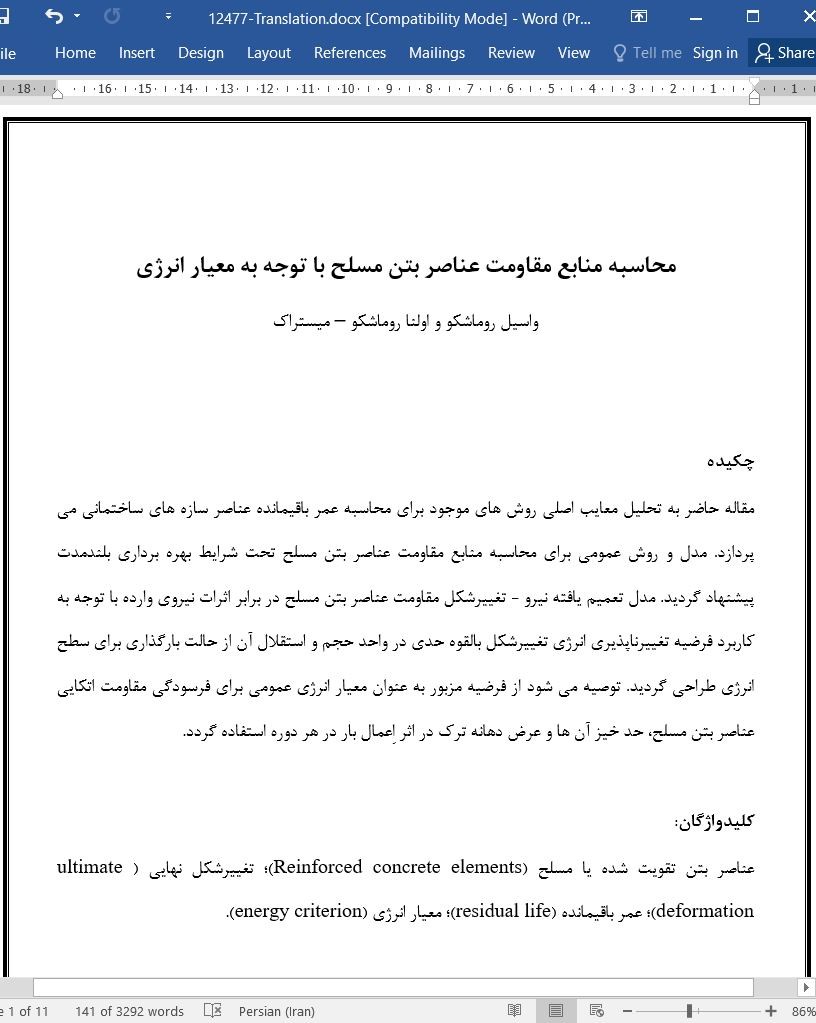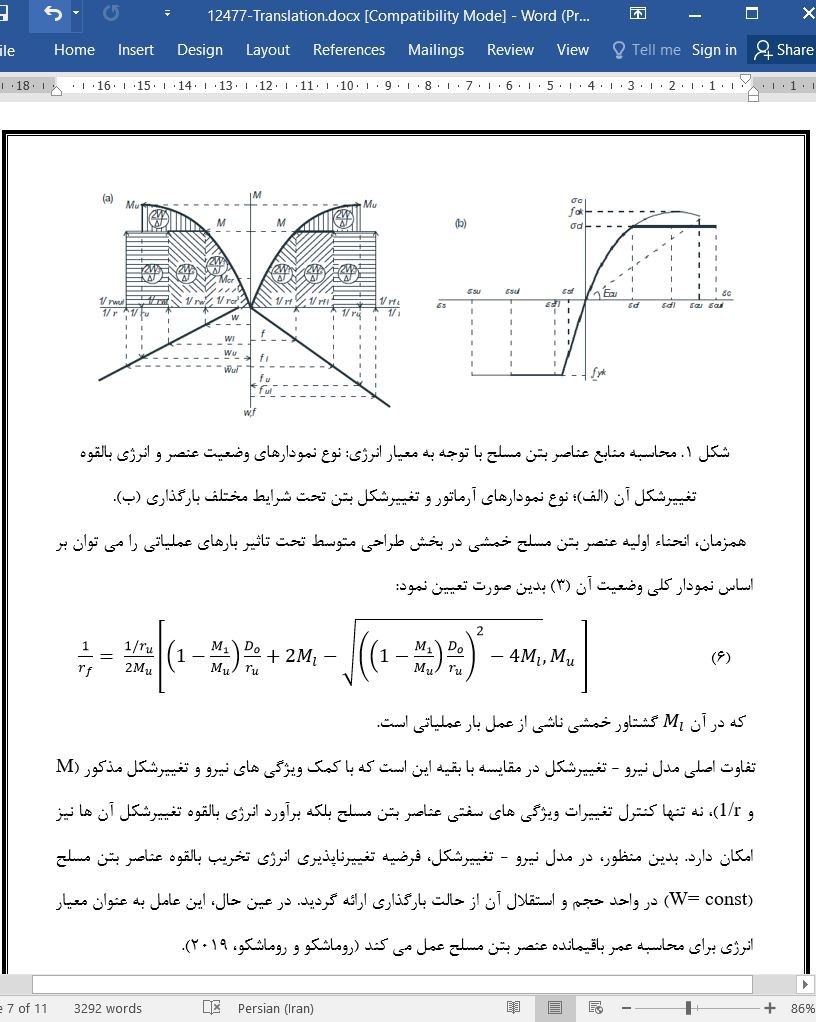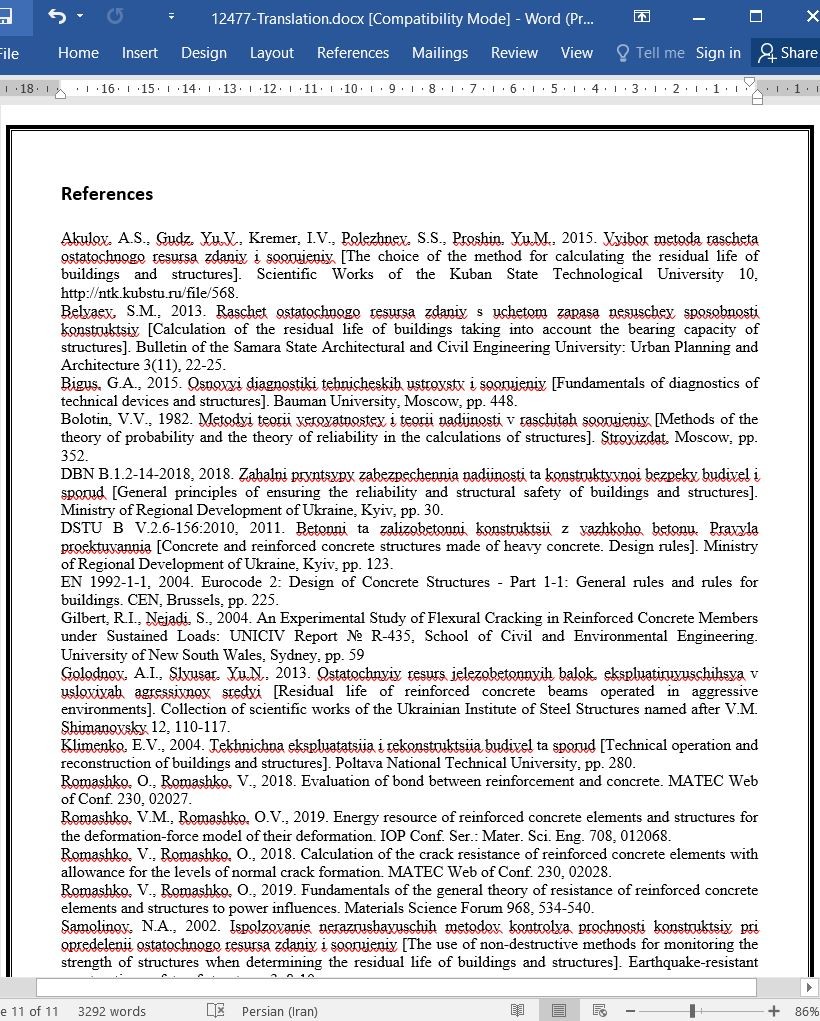
محاسبه منابع مقاومت عناصر بتن مسلح با توجه به معیار انرژی
چکیده
مقاله حاضر به تحلیل معایب اصلی روش های موجود برای محاسبه عمر باقیمانده عناصر سازه های ساختمانی می پردازد. مدل و روش عمومی برای محاسبه منابع مقاومت عناصر بتن مسلح تحت شرایط بهره برداری بلندمدت پیشنهاد گردید. مدل تعمیم یافته نیرو - تغییرشکل مقاومت عناصر بتن مسلح در برابر اثرات نیروی وارده با توجه به کاربرد فرضیه تغییرناپذیری انرژی تغییرشکل بالقوه حدی در واحد حجم و استقلال آن از حالت بارگذاری برای سطح انرژی طراحی گردید. توصیه می شود از فرضیه مزبور به عنوان معیار انرژی عمومی برای فرسودگی مقاومت اتکایی عناصر بتن مسلح، حد خیز آن ها و عرض دهانه ترک در اثر اِعمال بار در هر دوره استفاده گردد.
1. مقدمه
تعیین وضعیت تنش – کرنش واقعی عناصر و سازه های ساختمانی با تعیین منابع باقیمانده آن ها همواره یکی از امور اولیه ای است که باید در خلال بازسازی و مدرن سازی اشیاء ساختمان حل و فصل شوند. این امر به طور خاص برای عناصر بتن مسلح مشکل می باشد زیرا مستلزم مدلسازی ویژگی های سفتی واقعی آن ها در خلال بهره برداری بلندمدت می باشد. در اکثریت قریب به اتفاق روش های موجود، شرایط فنی واقعی عناصر و سازه های بتن مسلح مورد بهره برداری با توجه به ویژگی های مقاومت مصالح و کلیت عیوب و خسارات مشخص شده مورد ارزیابی قرار می گیرند. تحت چنین شرایطی، سفتی عناصر بتن مسلح در خلال بهره برداری را می توان تنها با استفاده از پارامترهای هندسی مقطع آن ها مدلسازی نمود. در عین حال، مشخص شده که تغییر سفتی به علت پارامترهای تغییرشکل، به ویژه کاهش در مدول تغییرشکل های بتن به دلیل خزش آن، مشهودتر می باشد چرا که حتی بدون تغییر ویژگی های هندسی مقطع عرضی فشرده عناصر یا سازه ها نیز رخ دهد. در عناصر خمشی، تغییر پارامتر تغییرشکل مزبور نیز با تغییر ویژگی های هندسی عناصر بتن مسلح به دلیل توسعه تغییرشکل و ترک خوردگی تحت شرایط بهره برداری بلندمدت همراه است.
5. نتیجه گیری
بذین ترنیب و بر اساس نتایج تحقیقات، نتایج زیر را می توان استخراج نمود: کاربرد معیار انرژی فرسودگی مقاومت اتکایی عناصر و سازه های بتن مسلح به منظور توسعه مدل تعمیم یافته نیرو - تغییرشکل مقاومت آن ها در برابر نیرو برای سطح انرژی مجاز است. فرضیه تغییرناپذیری در واحد حجم و استقلال از حالت بارگذاری انرژی بالقوه تغییرشکل عناصر بتن مسلح، محاسبه منابع مجموع و باقیمانده آن را از روی مواضع روش شناختی همسان ممکن می سازد؛ استفاده از معیار انرژی فرسودگی مقاومت اتکایی عنــاصر و سازه های بتن مسلح، محاسبه مستقیم منابع مجموع و باقیمانده آن ها را از روی پارامترهای تغییرشکل اندازه گیری شده مطالعات میدانی (خیزها، میزان شیب و عرض ترک های معمولی) ممکن می سازد. پیش بینی عمر باقیمانده عناصر و سازه های بتن مسلح نیازمند مطالعات دقیق پارامترهای خزش بتن می باشد.
Abstract
The article analyzes the main disadvantages of existing methods for calculating the residual life of building structure elements. A universal model and method for calculating the strength resource of reinforced concrete elements under conditions of long-term operation are proposed. The generalized deformation-force model of reinforced concrete elements resistance to force effects is developed up to the energy level due to the application of the hypothesis of invariability of the limiting potential deformation energy per unit volume and its independence from the loading mode. This hypothesis is recommended to be used as a universal energy criterion for the reinforced concrete elements bearing strength exhaustion, limiting their deflections and crack opening widths under the action of loads of any duration.
1. Introduction
Establishing the building elements and structures actual stress-strain state with the determination of their residual resource will always remain one of the priority tasks that have to be solved during the reconstruction and modernization of building objects. This task is especially difficult for reinforced concrete elements, since it requires modeling their real stiffness characteristics during long-term operation. The overwhelming majority of the existing methods, the actual technical condition of the exploited reinforced concrete elements and structures is assessed according to the materials corresponding strength characteristics and the identified defects and damages totality. Under such circumstances, the reinforced concrete elements stiffness during their operation can be modeled only using the geometric parameters of their section. At the same time, it is known that a change in stiffness due to deformation parameters, in particular a decrease in the modulus of concrete deformations due to its creep, is more significant, since it can occur even without changing the geometric characteristics of the compressed cross-section of elements or structures. And in bending elements, it is the change in the mentioned deformation parameter that is also accompanied by a change in the geometric characteristics of the reinforced concrete elements section due to the deflections development and crack opening under conditions of long-term operation.
5. Conclusion
Thus, based on the research results, the following conclusions can be drawn: the application of the energy criterion of the reinforced concrete elements and structures bearing strength exhaustion allowed to develop a generalized deformation-force model of their resistance to force to the energy level; the hypothesis of invariance in unit of volume and independence from a loading mode of potential energy of a reinforced concrete element deformation allows to carry out calculation of its total and residual resources from uniform methodological positions; the use of the energy criterion of the reinforced concrete elements and structures bearing strength exhaustion allows to calculate their total and residual resources directly from the measured deformation parameters of field studies (deflections, pitch and normal cracks width); forecasting the reinforced concrete elements and structures residual life requires detailed studies of the concrete creep parameters.
چکیده
1. مقدمه
2. تجزیه و تحلیل آثار و تحقیقات پایه
3. مواد و روش های تحقیق
4. نتایج تحقیق
5. نتیجه گیری
منابع
Abstract
1. Introduction
2. Analysis of basic research and publications
3. Materials and research methods
4. Research results
5. Conclusion
References
- اصل مقاله انگلیسی با فرمت ورد (word) با قابلیت ویرایش
- ترجمه فارسی مقاله با فرمت ورد (word) با قابلیت ویرایش، بدون آرم سایت ای ترجمه
- ترجمه فارسی مقاله با فرمت pdf، بدون آرم سایت ای ترجمه



